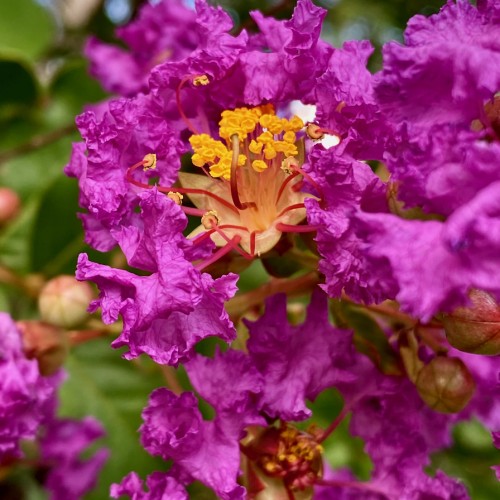
crape myrtle
Lagerstroemia 'Mardi Gras'
Cycle:
Perennial
Watering:
Average
Hardiness Zone:
5 - 9
Flowers:
Flowers
Sun:
Full sun
Leaf:
Yes
Growth Rate:
High
Maintenance:
Moderate
Drought Tolerant:
Yes
Care Level:
Moderate
watering
Crape myrtle (Lagerstroemia 'Mardi Gras') should be watered thoroughly and deeply 1-2 times per week, allowing the soil's top few inches to dry out between waterings. In addition, plants should be watered more during periods of drought and during the summer months. When watering, the soil should be completely saturated, and it is best to water in the morning to avoid mildew and water-logging. During winter dormancy, it is typically not necessary to water the plants.
sunlight
Crape myrtle (Lagerstroemia 'Mardi Gras') requires around 8-10 hours of direct sunlight each day in order to thrive. It should be grown in areas that provide full sun throughout the morning and mid-day, with some dappled shade in the late afternoon. It is important to ensure that the Crape myrtle is exposed to maximum sunlight in the summer months, as this will helps promote the most vibrant foliage and bloom colors.
pruning
When it comes to pruning a Crape Myrtle (Lagerstroemia 'Mardi Gras'), the amount of pruning needed will vary based on the size of the plant and the desired look. Generally, it is best to wait until the plant is at least 3-4 years old before pruning, as young plants require more frequent and intensive pruning. For an established Crape Myrtle, pruning should occur once a year in the late winter or early spring, before new growth begins. Focus on removing dead, broken, and crossing branches to improve the overall structure and air flow of the plant. The amount of pruning can vary depending on the desired look, but typically it shouldn't be more than about 1 third of the total size of the plant. During pruning, you should also be careful not to remove any healthy wood. Once the desired shape has been achieved, you can use pruning sealer to reduce the risk of infection and help the plant heal faster.
